McCaslin Frost
10 December 1785 - 12 May 1874
On
July 4, 1776 the American Colonies declared their independence from
Great Britain, they had already been at war with their Mother Country
for well over a year. The Declaration of Independence did not resolve
the matter. It was a long and costly struggle that did not end until
the British surrendered to General George Washington at Yorktown on
October 19, 1781. The formal end of the war did not occur until the
Treaty
of Paris
and Treaties
of Versailles
were signed on September 3, 1783. The last British troops left
New York City on November 25, 1783, and the United States Congress
of the Confederation ratified the Paris treaty on January 14, 1784.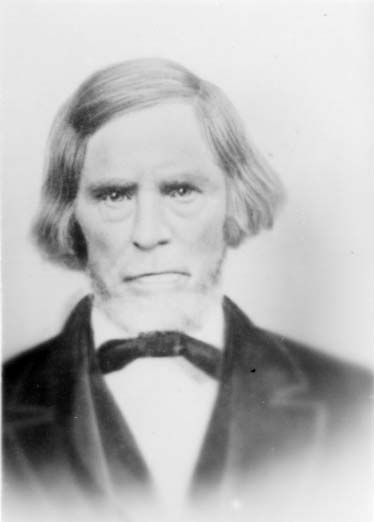
While the diplomats and statesmen worked out the details of the treaty, those who had fought so gallantly and where fortunate enough to survive the war went home to their families and livelihoods. Among them was Captain James Frost, an iron maker who lived in Rockingham County, North Carolina. Captain Frost was a veteran of the Battle of Ransom's Mill and the decisive Battle of Guilford Courthouse.
McCaslin Frost was the son of James and Isabelle Van Dyke Frost. He was born December 10, 1785 in Rockingham, Richnond County, North Carolina. He was the fifth child in a family of 9 children - 7 boys and 2 girls. Elekiel (8 Jul 1772), John (1776), Jonas (1778), James (1780), Nicholas (about 1781), McCaslin, Sarah (1788), Rachel (about 1790), and Samuel (about 1793). McCaslin's father was English and his mother was Dutch.
James and Isabelle had moved from Pennsylvania to Rockingham County after the birth of their first two sons. In 1795 they moved their large family to Johnston County, North Carolina.
Little is known of the early life of McCaslin Frost. He was born just a couple of years after the Revolutionary War, and most of his life was spent under pioneer conditions, living on the frontier in the five states of the union where he resided - North Carolina, Tennessee, Iowa, Illinois and Utah.
McCaslin was slender and of medium height. He had blue eyes and a light complection. He was humorous, kind, sympathetic, and of a jovial disposition. Judging from the childhood experiences related to his grandchildren when they were small, McCaslin's father must have owned slaves. The slaves idealized McCaslin and called him "Massa" (Master), and went to him with their troubles, sure of sympathy and understanding. But he couldn't always resist the opportunity of playing some harmless prank on them when the occasion presented itself and was amused at some of the ridiculous situations he found them in.
A young woman by the name of Peninna Jane Smith came to live with the Frost family. She was the daughter of John and Margaret Brown Smith and was born on February 1, 1794 in Wayne County, North Carolina. There were 6 children in the Smith family. Three girls and three boys. Peninna was the fourth child, the other children were Nancy (2 Jul 1789), Jesse (5 Jun 1791), Stephen (11 May 1793), and Fereba (about 1795). When Peninna was four years old, her mother died in childbirth. After the death of her mother, Peninna made her home with an Aunt. When the aunt died, Peninna came to live with James Frost and his wife, Isabelle, who were probably old friends of her parents.
It
was under these circumstances that McCaslin and Peninna became
acquainted. A little too acquainted. When McCaslin and Peninna were
married on November 28, 1809 in Johnson County, North Carolina, she
was expecting their first child. It is a fact that around the turn of
the eighteenth century, one third of brides in the United States were
already pregnant when they married. At the time of their marriage,
McCaslin was 23 and Peninna was about 15. it is also a fact that
girls married much younger in those days. 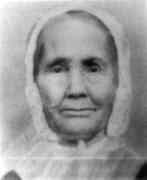
Peninna Smith Frost,
in later years
McCaslin and Peninna first made their home in neighboring Wake County, North Carolina where their fist child, Samuel Buchanan, was born on January 2, 1810. He was followed by his sister, Nancy Ilewood on August 12, 1812.
Around the time that his father died in 1815, McCaslin and Peninna moved to Knox County, Tennessee, near Knoxville, the main city in the eastern part of the state. This is a mountainous region, and had been settled only a short time when they were married. They lived on a river or possibly a creek. At the foot of the hill below their house was a wonderful cold spring. They built a room over this spring and used it not only for drinking water and culinary purposes but also for the refrigeration of their dairy products. Their crocks of milk, butter, and cheese were kept in excellent condition.
The rest of their eight children were born in Knox County The other children were: Isabelle VanDyke (14 Feb 1816), Fereba Smith (17 Sep 1818), James William (30 Aug 1820), Martha McKinney (7 Oct 1825), Mary Ann (27 Oct 1827), and Margaret Elzira (28 Apr 1830).
They were a musical family and sang many old folk songs, some of which are known to have been old English folk songs. McCaslin's father made a violin and presented it to the first one of his boys who learned to play it. McCaslin won the violin, and many years later he gave it to one of his sons, who played it at many pioneer dances and entertainments after he came to Utah. All the family could sing, dance, and play. McCaslin's oldest son, Samuel B. Frost could "fiddle", step dance, and sing, all at the same time and still not be short of breath.
Times were hard during that period. When Samuel was a young man, he went north one winter and secured work in Hancock County, Illionis. He liked the country and the opportunity it afforded and decided to remain their. In 1834 he married Rebecca Foreman in Hancock County and began raising a family of his own.
Two of McCaslin's and Peninna's children died before reaching adulthood. Mary Ann had died on August 24, 1829 when she was two years old. James William died in October 1834, when he was a lad of fourteen.
Isabelle was married in about 1835 to Wiley Jones, also a native of Tennessee. Nancy married Archibald Kerr of Knoxville in May 1833. Fereba married William Harrison Barger, a native of Indiana, in Fairfield, Iowa in about 1837. After his death by drowning on July 23, 1858, Fereba married Revrand John E. Beatty at Sidney, Iowa in February 1862.
McCaslin being a straunch Methodist hated to break the Sabbath but he shot and killed a big turkey which became the main course the next day for the wedding of Martha McKinney, or Patsy as she was called, when she married Harmon Akes in the spring of 1840.
While living in Illinois, Samuel became acquainted with the Latter-day Saints and was converted to Mormonism. He was very enthusiastic over his new religion and early in the spring of 1841 he returned to his old home in Tennessee for a visit and to explain the principles of the gospel to his family. Not only was the Frost family converted to his new belief but also a number of their neighbors as well. A hole had to be cut in two feet of ice to baptize his parents and part of the rest of the family. Margaret was too young; Fereba was married and away; and Isabelle never did join the church because of her husband's objections.
After becoming interested in Mormonism, McCaslin was eager to join the people of his faith. They left their home in Knox County and began their journey to Illinois. They went first to Memphis, Tennessee where McCaslin worked for a short time before beginning their voyage up the Mississippi River to Iowa where they stopped off for a while to see their daughters Fereba. Then on to Illinois where they resided for the next few years. They rented a place five miles from Carthage, Hancock County, and lived there for a few years.
Peninna and their daughter, Martha were members of the Relief Society when it was first organized in 1842.
At the time of the martyrdom of the Prophet Joseph and Hyrum Smith, the Patriarch, on June 27, 1844 the Frost family was living about five miles from Carthage jail, and when the word reached the people of the ruthless murder of their beloved Prophet and his brother, they could hardly believe it and sent messengers to investigate.
It
was a crushing blow to the Saints, and almost more than they could
endure. But they listened to those in authority, although they could
have called out the Nauvoo Legion to avenge the deaths of their
leaders, they allowed their enemies to go in peace, and waited for
the law to punish the assassins. The Frosts could see from the doorway
of their home, the smoke from other Mormon villages which were being
burned by mobs. McCaslin moved his family from this home soon after
this time.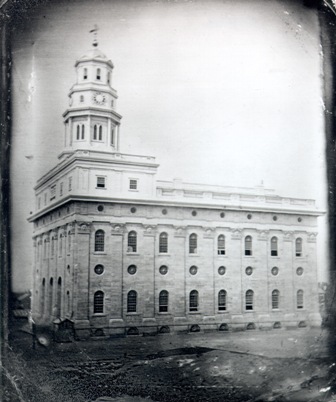
The original Nauvoo Temple
Both McCaslin and Peninna were endowed and sealed in the Nauvoo Temple on January 5, 1846 before leaving the city. Martha's husband and all three of their children died in Nauvoo. She married George Washington Langley on January 20, 1846 in the Nauvoo Temple.
When the persecution became too intense, McCaslin moved his family to Iowa, where prejudice against the Latter-day Saints was not so intense, and where they could enjoy comparative peace and freedom from persecutions.
In the Fall of 1846, McCaslin and Samuel B. went to Nishnabotna, Iowa about sixty miles further down the river from Council Bluffs, where Samuel B. bought a place and they all lived there for a time. While living in Iowa, McCaslin's youngest child Margaret Elzira married Harvey McGallard Rawlins, a native of Illinois on December 3, 1846 in Nishnabotna, Iowa.
McCaslin's family slowly made their way west to Utah. The fist to make the trek were his daughters Margaret and Martha, who both crossed the plains with their families in 1848 with the Heber C. Kimball Company.
McCaslin and Peninna remained in Iowa until 1856 when they set out for Utah along with their daughter Nancy and her family in the Philemon C. Merrill Company on June 5, 1856. At the time McCaslin was 69 and Peninna was 62. Two hundred individuals and fifty wagons were in the company when it began its journey from the outfitting post at Florence, Nebraska.
All went along very peacefully until one night camping on Wood River, something was seen to crawl in among the cattle just before they stampeded, overturning some wagons in their pellmell rush. (pellmell 1. In a jumbled, confused manner; helter-skelter.2. In frantic disorderly haste; headlong) When crossing the plains in Indian country Cattle were very easily stampeded. They had to stay there for three days gathering up cattle, some never were found, having got mixed in with the buffalo.
That
season the buffalo were very thick on the plains. Herds of thousands
were seen everyday. Sometimes the wagon train had to stop while the
herds went past to water. One day while nooning on Wood River, a big
herd came charging over the hills. All hands were called out with
guns and fired into them to head them off. Another time while
traveling, buffalo stampeded the whole train, causing some accidents.
Some of the ladies got badly bruised by being thrown from the wagons.
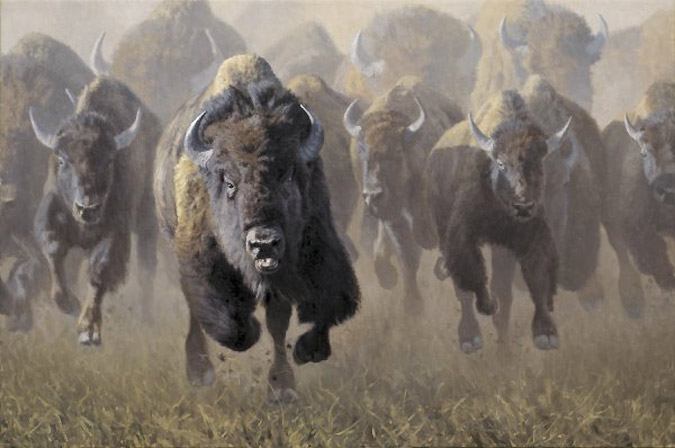
Full Throttle by Kyle Sims
Most of the emigrant trains traveled on the south side of the Platte River up to Fort Laramie. But they traveled all the way on the north side. Captain Merrill said they would find the best feed on the north side of the river. In going over the hills to Sweet Water Creek they had to camp one night without water. There was about thirty five miles between sources of water.
At Fort Laramie an exciting incident occurred. One evening a young Indian buck rode up to the campfire around which they were gathered. He said little but kept watching a certain young woman. Finally, in the best way he was able, he made them understand that he wanted the young girl for his squaw. He offered her father his best pony in the trade, remarking "He is heap good pony. Better, than white man's." The girl had stood by her mother, but became frightened and climbed into the wagon.
After arguing the question to no purpose, the Indian rode away apparently angry and much disturbed. Some apprehension was felt in the camp, and close guard was kept through the night, but nothing more occurred to alarm them. The captain had told the girl never to lose sight of camp, as it was not safe.
At Independence Rock the train halted for one hour, giving the people a chance to gather saleratus. About 1.6 miles northeast of Independence Rock, as the emigrants approached the Sweetwater River, they reached Saleratus Lake. Saleratus is a naturally occurring sodium or potassium bicarbonate. It was used as as a leavening agent and it was used as a raw form of baking soda.
After leaving the Platte river they traveled through Black Hill country. It was thought best to divide the train into three divisions as feed was in smaller patches and more scattered than on the great Platte meadows. The three divisions traveled about one half day's drive apart until they reached the Big Mountain. In going over the mountain, they had the first view of the Salt Lake Valley in the distance which made all rejoice, realizing that their journey's end was near.
On the 14th of August they nooned at the head of Parley's canyon. Early the next morning they hitched up and got on the trail. About four miles down the canyon the road passed over what is termed the hogs back, where the road was cut through a hill. At that point, they had a full view of Salt Lake City and the valley. The blue water of the Great Salt Lake was in the distance and the beautiful settlements in the foreground. The scene before them was what they had long looked for, and read and sung about; the City of the Saints. Joy filled each bosom at the sight. About noon the 15th of August they rolled into Emigration Square in Salt Lake City.
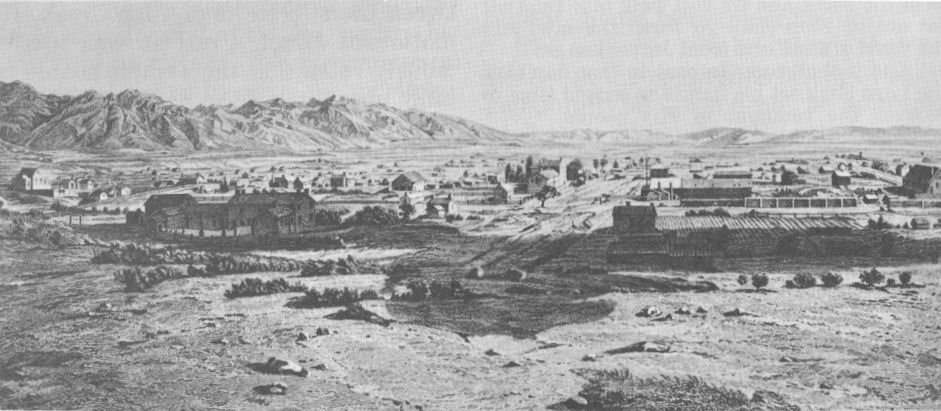
Salt Lake City during the 1850's
Upon arriving in the Valley, McCaslin and Peninna were reunited with Martha and Margaret. Martha's second husband had died and in 1851 she married John McCormick Wiser. They spent the closing years of their lives living with their children. At first they lived in the homes of their daughters in the Salt Lake Valley for a few years. When Samuel came to the Utah Territory in 1861, they went to Spring City to live with him and second new wife, Ester Davis, for a while. His first wife had died in 1858 while t hey lived in Iowa.
Of McCaslin's six children who grew to adulthood, five of them came west and made their homes sometime during the westward migration. Four had joined the L.D.S. Church and came to Utah. Later during the 1860's Isabelle came to Idaho and settled for a short time in Lost River but later moved to California and settled there. Fereba and her family remained in Iowa and later moved to Nebraska.

Samuel, Martha, Nancy, and Margaret in 1886
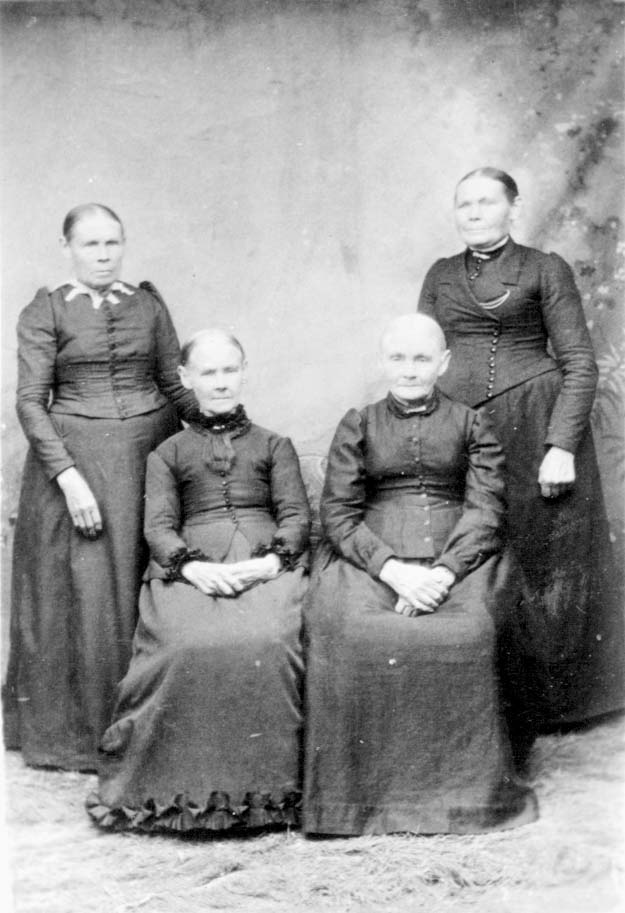
Martha, Fereba, Nancy, and Margaret
After a few years in Spring City, McCaslin and Peninna went to live with Margaret in Richmond, Utah in Cache Valley. Peninna was very sick for some time. She died September 8th, 1869 in Richmond, Cache County, Utah. McCaslin remained with the Rawlins family. They moved to Lewiston, Cache County, Utah in1871 which became their permanent home. McCaslin made violins but lost his hearing before his death so someone else tuned them for him then he could play the old tunes he knew. After being ill for about two weeks, he died May 12, 1874 at Lewiston at the age of 88. McCaslin and Peninna Frost are buried in Richmond, Utah.
* * * * * *
McCaslin received his patriarchal blessing in Alpine, Utah, 16 March 1857 from Elmer Harris.
A blessing by Elmer Harris, Patriarch, upon the head of McCaslin Frost, son of James and Isabelle Frost, born December 11th, 1785 at Rockingham County, North Carolina.
Brother McCaslin, I lay my hands upon your head in the name of Jesus of Nazareth and place upon you a father's blessing. Thou art of the seed of Abraham and came down through the lineage of Ephraim therefore thou art a legal heir to the priesthood which has came down through the lineage of the fathers even unto thee. Thou art also entitled to the good things of the Earth and the fruits thereof. Thy posterity shall become numerous and thou shalt live to see thy children's children. Thou shalt have seen many days of toil and affliction but thy evil days are drawing to a close and thy latter days shall be better than thy former. Thy days shall be lengthened out until thou art satisfied with life. The power of the highest shall rest upon you to comfort and console you in your declining years and the desires of thy heart shall be given you. Rejoice therefore in your God for he is nigh unto all who seek him diligently. Fear not but keep the commandments of God and all those blessings shall be made sure unto you together with all former blessings and by the authority of the Holy Priesthood I seal this, a father's blessing upon thy head in the name of Jesus Christ. I seal you up unto eternal lives, even so, Amen.
* * * * * *
The main source of this story is an uncredited life story of McCaslin Frost
Information about marriage in the early 1800 is from "Everyday Life in the 1800s" by Marc McCuctcheon, Chapter 10 Courtship and Marriage, page 205:
Details of the Philemon C. Merrill Company are from trail exerts found at: http://www.lds.org/churchhistory/library/pioneercompany/1,15797,4017-1-204,00.html
See also
The life story of Martha McKinney Frost
The life story of Margaret Elizirah Frost